SAEDNEWS: The Grand Bazaar of Tabriz is considered one of the oldest and largest covered markets in the world. It blends rich cultural heritage with vibrant commerce, serving as a major economic and social hub in northwestern Iran.
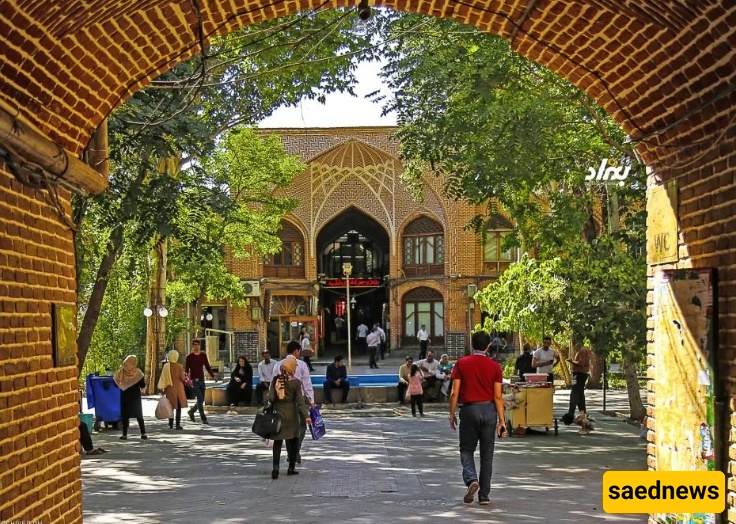
Our journey begins in the land of pioneers, taking us to the largest covered bazaar in Iran and the world’s most extensive interconnected brick complex. The historic Tabriz Bazaar stretches over one kilometer, having withstood numerous historical events to reach us today as a treasured heritage site. It consists of over 6,500 shops, 40 types of professions and crafts, 20 commercial lanes, 35 caravanserais, 25 domed halls (Timchehs), and 11 corridors. It also includes several schools, mosques, inns, and bathhouses—together forming the most complete and well-organized social structure among Iran's traditional markets.
Most of the goods sold in the Tabriz Bazaar reflect traditional Iranian culture. Unlike modern shopping centers, you won't find electronics like computers here. Instead, the bazaar offers a wide range of heritage-rich products such as handmade carpets from Tabriz and Azerbaijan, leather bags and shoes, spices, herbal and medicinal products, nuts, fabrics, glassware, and much more.
National and World Heritage Registration
Due to its remarkable architectural and commercial significance, the Tabriz Bazaar was registered as a national heritage site of Iran in 1975 (under No. 1097). Later, in August 2010, it was inscribed as a UNESCO World Heritage Site (No. 1346), making it the largest Iranian site to be included on the World Heritage List.
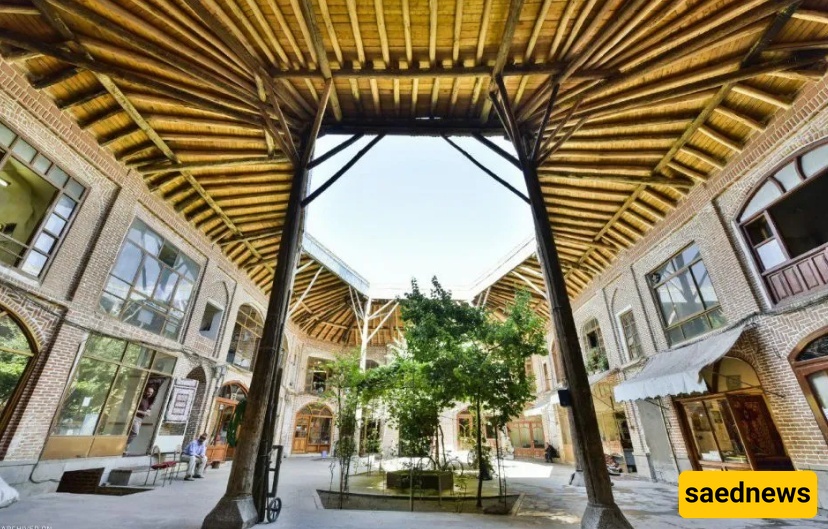
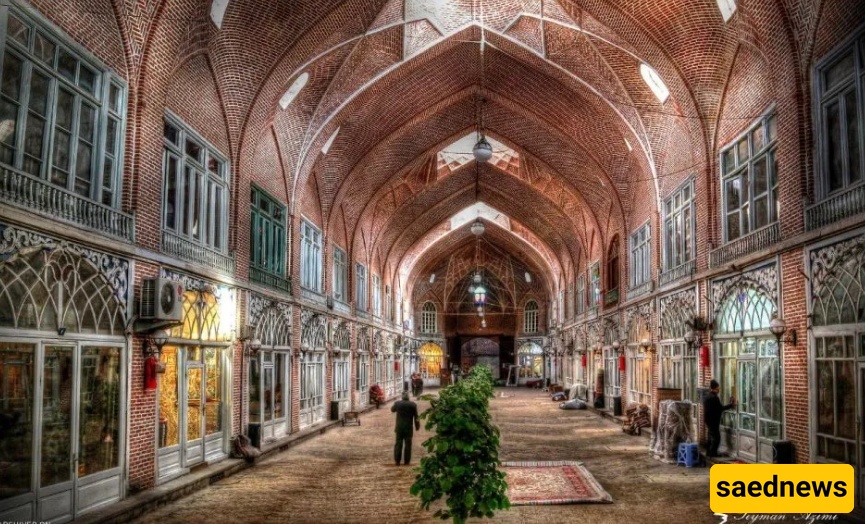
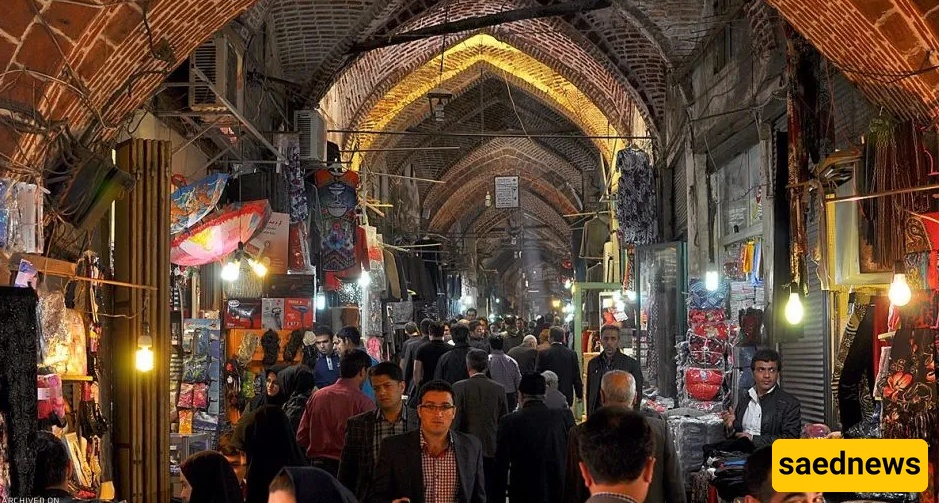
In the following, we’ll try to guide you a bit through shopping and exploring inside the Tabriz Bazaar. As mentioned before, you are now in the largest covered market in the world—and chances are, you won’t return home empty-handed!
Amir Bazaar is one of the most beautiful and important sections of the Grand Bazaar of Tabriz. It serves as the main hub for trading gold and jewelry. This part of the market is among the busiest and most vibrant, attracting numerous tourists and merchants every day. The bazaar features around 112 shops, of which 102 are dedicated to the crafting and selling of gold and jewelry. The remaining shops offer a variety of goods such as fabrics, perfumes, and beauty products.
Dating back to the Qajar era, Amir Timcheh is one of the most iconic sections of the bazaar where many of Tabriz’s goldsmiths and jewelers work. Located near the Medina Square and the entrance to the main bazaar, it is designed in an octagonal layout with two levels of shops. Amir Timcheh also features the largest brick dome in the entire market, adorned with delicate arches and beautiful decorative patterns.
Mozaffarieh is among the most famous and visually stunning sections of the Tabriz Bazaar. It is a major center for the carpet trade in East Azerbaijan Province, offering some of the most exquisite and luxurious handmade carpets in the region. In addition to selling rugs, many shopkeepers here are skilled in carpet design, repair, and the creation of decorative carpet panels. Notably, machine-made rugs are strictly prohibited in Mozaffarieh—only authentic handmade pieces are allowed inside.
The Timcheh Sheikh Kazem complex is located at the intersection of Rasteh Jadid and Rasteh Sabbaghiyan in the Tabriz Bazaar. It is bordered by the Qezbasti Bazaar shops to the north, Rasteh Jadid to the east, Rasteh Sabbaghiyan to the south, and Saray Gorjilar to the west. Most of the shopkeepers in this section sell women’s and children’s clothing. Additionally, the towel vendors' guild owns several shops in this area.
This bazaar was historically a place for selling glassware such as crystal in Tabriz. Its timchehs and saras include Timcheh Ghandfrooshan, Timcheh Mozaffariyeh, Dalan Bamchilar, Dalan Haj Sheikh, Dalan Mirza Mohammad, Saray Mirza Mohammad, and Saray Gorjilar.
Previously, this bazaar was a hub for selling and producing glassware, with most of its shops dedicated to glassmaking. It had two saras called Haj Rasoul and Mirza Ali Naqi, both of which were demolished by the Tabriz municipality to make way for the Shams Tabrizi market and garden. Today, the bazaar sells various cosmetics and stationery items. It is located between Tarbiat and Shohada streets.
As the name suggests, this is one of the most important centers for shoe manufacturing and sales in Tabriz. The shops are used for tailoring and selling various types of handmade shoes. Sections of this market include Timcheh Omid, Timcheh Haj Abolghasem, Saray Omid, and Saray Haj Abolghasem.
“Yemeni” refers to a traditional type of footwear in Tabriz that resembles charogh (a kind of local shoe). This bazaar was historically where such shoes were stitched.
One of the largest sub-bazaars in Tabriz, it includes many timchehs and saras, and sells a wide range of goods. It is also known as the "National Bazaar."
A section dedicated to the sale of traditional herbal medicine and various spices.

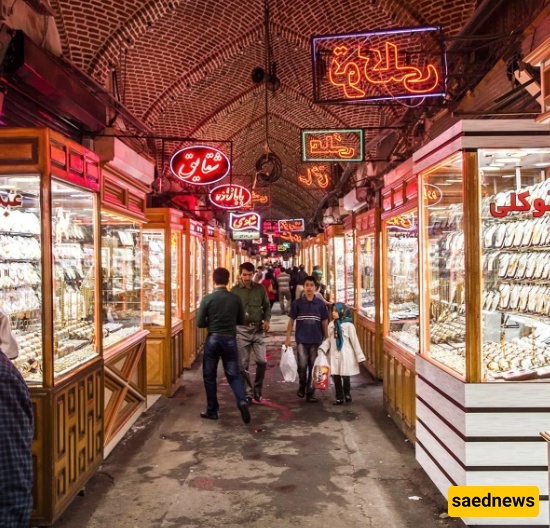


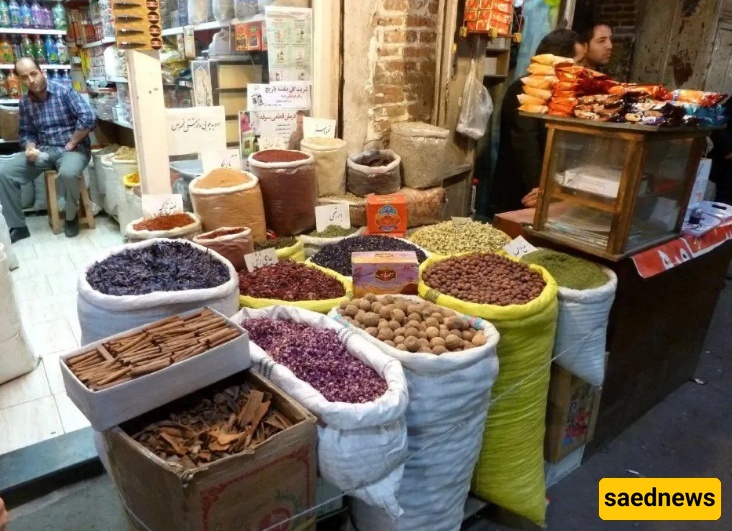
There is no precise documentation regarding the Bazaar of Tabriz prior to the advent of Islam or even up to the 10th century AH (4th century Hijri). The earliest references to the bazaar appear in the travelogues and writings of explorers from that era, indicating that this site may in fact be the oldest covered bazaar in the Middle East. What truly elevated the importance of the Tabriz Bazaar throughout history, however, was its strategic location along the Silk Road. Historically, the influence of the bazaar was so profound that the city gates were considered synonymous with the main entrances to the market.
The name “Bazaar of Tabriz” began to emerge during the Seljuk dynasty, with remnants from that period indicating the presence of a large complex on the current site of the bazaar with similar commercial functions. However, the bazaar rose to new prominence when Tabriz became the capital during the Ilkhanid era. At that time, there were three major commercial centers along the Silk Road: one in China, one in Iran (Tabriz), and one in Rome. Tabriz held a pivotal role in this trio.
This commercial prominence continued into the Safavid era, when merchants from near and far flocked to Tabriz for trade. However, the city suffered from devastating earthquakes over the centuries, many of which destroyed significant parts of the urban fabric—including the bazaar itself. Nevertheless, the historical market was restored multiple times, with buildings being added or demolished based on necessity or change in function.
One of the most catastrophic events occurred in 1193 AH (1758 AD) when a powerful earthquake leveled much of the bazaar. Yet, not long after, during the late Zand and early Qajar periods, the bazaar was rebuilt under the supervision of Najafqoli Khan Donboli, the then-governor of Tabriz. The current layout and structure of the bazaar largely date back to this reconstruction.
During the Qajar era, the Grand Bazaar of Tabriz retained its prosperity and strategic significance for two main reasons:
Tabriz served as the residence of the Crown Prince.
Its proximity to European markets made it a crucial point of exchange.
In the early 19th century (13th century AH), under the reign of Abbas Mirza, the Tabriz Bazaar became a central hub for trade between Iran and the Western world. British merchants, for instance, used the Silk Road route—traveling through Istanbul and Trabzon—to reach Tabriz and distribute their goods throughout Iran. By the mid-1800s, the volume of trade conducted in this market accounted for approximately one-fourth of Iran’s total commerce, surpassing even that of Tehran.
Statistics from 1877 AD (1256 SH) indicate that 25–33% of Iran’s commercial transactions took place within the Tabriz Bazaar. By 1879 AD (1258 SH), it had also become a major trade center with Central Asia.
European imports brought into Iran included mirrors, silk and velvet fabrics, cotton, trousers, printed fabrics, sugar, glassware, metals, granulated sugar, and other mechanical goods. In return, Tabrizi merchants exported silk, synthetic silk, weapons, tobacco, nuts, dyes, shawls, gallnut, and wax. Despite the active trade relations, the terms of commerce ultimately favored European exporters, reflecting the broader dynamics of global trade during that era.

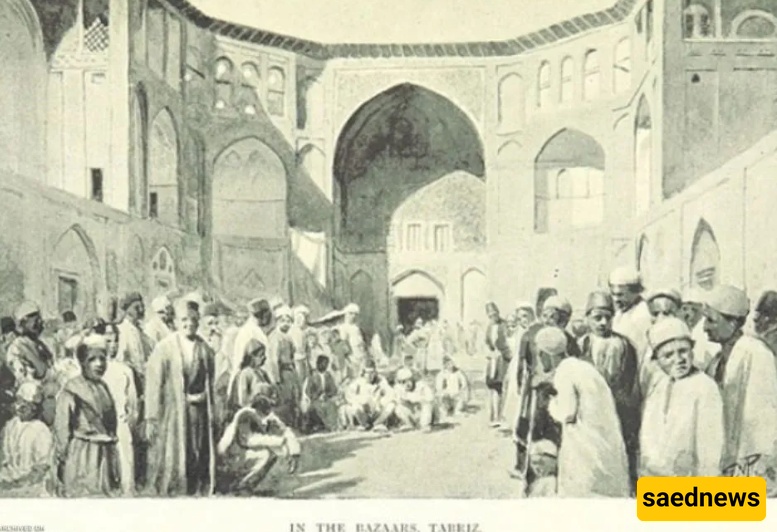
Architecture of Tabriz Bazaar:
The core structure of the Tabriz Bazaar consists of two covered streets extending from north to south and from east to west. The width of the bazaar ranges from 4 to 5 meters, while the ceiling height reaches between 5 and 6 meters. The streets are roofed with large brick domes, a design well-suited to the cold climate of Tabriz.
At the top of these domes are small openings that allow natural light to enter the bazaar, creating evenly distributed illumination throughout the space. These openings also serve as effective ventilation points for air circulation inside the market.
When studying the architecture of the Tabriz Bazaar, we observe that it was not built with a pre-planned layout. Instead, architects and designers gradually added new sections over time.
Naturally, as you’ve seen and read earlier, every traditional Iranian bazaar is composed of several distinct sections, and understanding these divisions and their concepts will make your experience visiting such markets much more exciting and enjoyable.
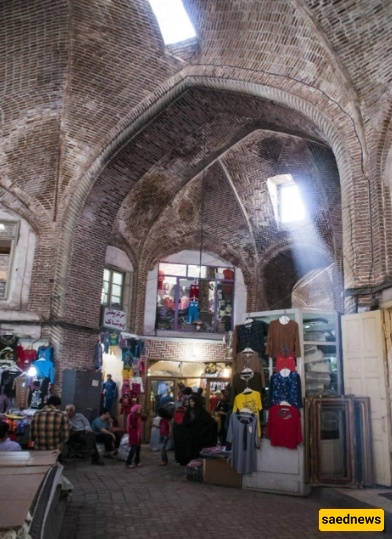
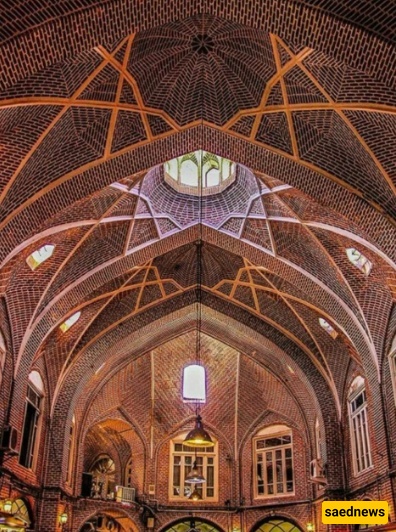
The bazaar consists of 5 main streets, 35 caravanserais, 19 corridors, 24 khans (inns), 2 chaarsoos (crossroads or covered bazaars), 1 square, 31 bazaars, 7 small bazaars, 20 teams or timchehs (small market halls), 3 shrines, 29 mosques, 4 schools, 6 baths, 1 zurkhaneh (traditional gymnasium), 1 icehouse, 2 bridges for the bazaar, 2 passages, 5 museums, 1 house, 8 gates, and 2 libraries. Below, we review some of the most important landmarks within the bazaar:
Timcheh Mozaffariyeh
It is considered one of the most famous and beautiful timchehs in Tabriz Bazaar. Timcheh Mozaffariyeh is one of the main centers for the trade of carpets and rugs in East Azerbaijan Province, where the finest and most beautiful handmade carpets in Tabriz can be found. In addition to buying and selling carpets, the merchants in this section of the bazaar also engage in designing and restoring various types of carpets and carpet panels.
This is one of the widest caravanserais in the bazaar, located on the eastern edge and the southern half of the bazaar complex. Amir Caravanserai is surrounded on all sides by chambers arranged over two floors, and in its center lies a rectangular courtyard measuring approximately 50 by 70 meters.
This mosque is one of the historical and beautiful buildings in Tabriz. It is mentioned in old texts as the "Great Jameh Mosque" and has been known since its founding as the main congregational mosque of the city of Tabriz. The mosque is located at the end of the bazaar and is said to date back to the Seljuk period. However, it was destroyed during the great earthquake of 1193 AH (Islamic calendar) and was restored during the Qajar era. To reach the Jameh Mosque, one should head to the end of the bazaar and to the southern side of Talebieh School.
Talebieh School is considered the most famous religious school in Tabriz Bazaar. Prominent scholars such as Allama Amini, Allama Tabatabai, Allama Jafari, Jaafar Subhani, and others studied there. To reach Talebieh School, you should head towards the Jameh Mosque, as the school is located next to it. The library of Talebieh School is one of the most famous libraries in Tabriz, housing more than 30,000 volumes of reference books, 350 volumes of manuscripts, as well as stone and lead inscriptions.
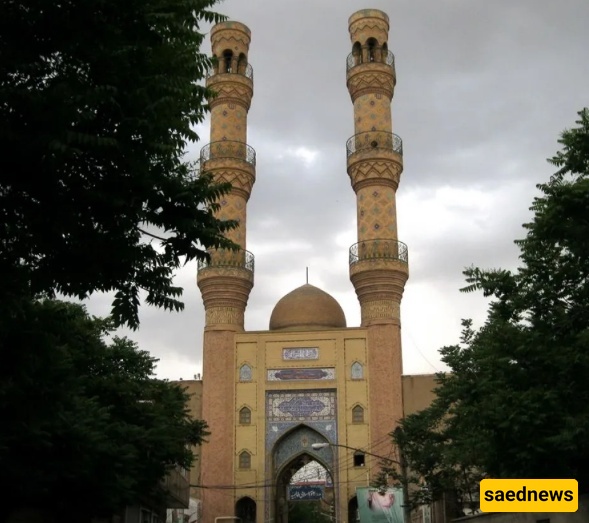
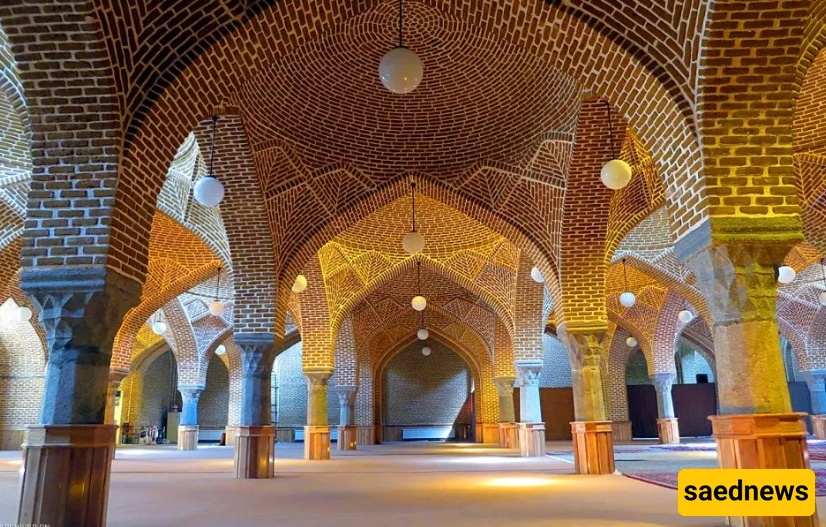
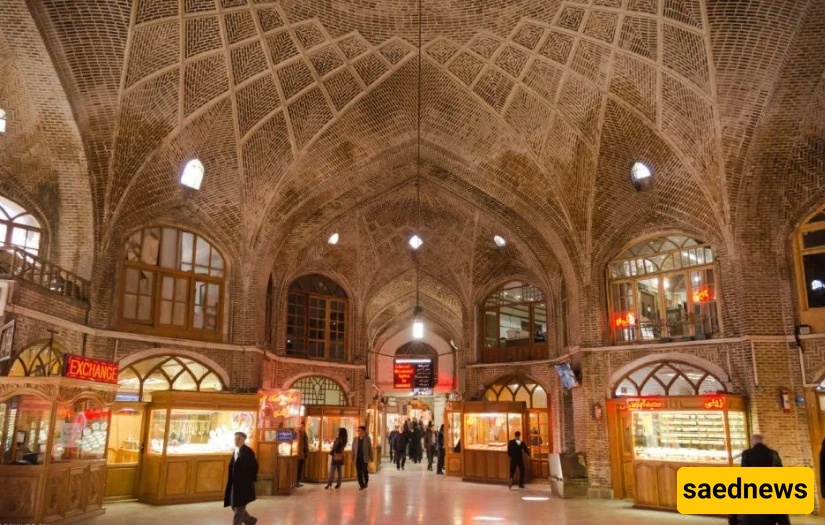
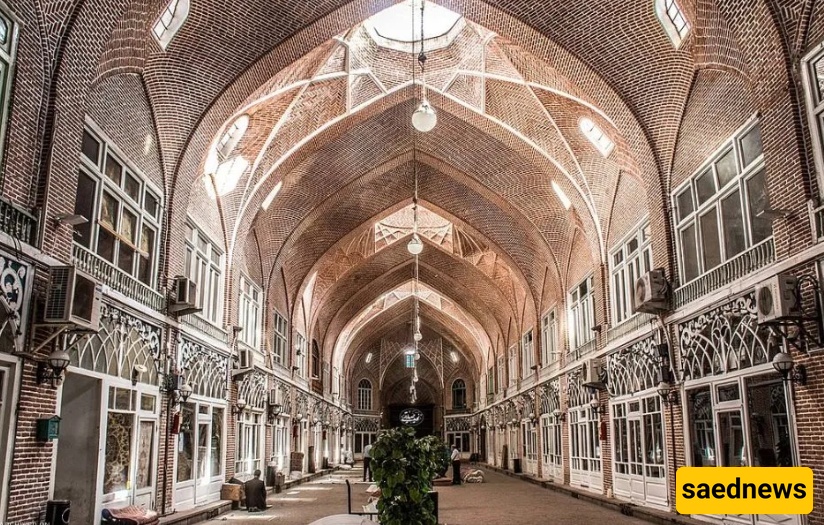
The history of this bathhouse dates back to the Qajar era and it is located on Teqeh al-Islam Street. Khan Bathhouse was registered on the Iranian National Heritage List in 1382 AH (solar calendar). This bathhouse used to be one of the luxurious bathhouses in Tabriz; today, however, it is used as a workshop for shoemaking crafts.
Near Talebieh School and inside Hajat Mosque (located on the right side of the alley), there is a small shrine known to people as Imamzadeh Jamal of Tabriz. This shrine contains the tomb of Imamzadeh Musa, known as Seyed Jamal, who is a descendant of Imam Musa ibn Jafar (peace be upon him).
Tabriz Bazaar contains five museums, and here we highlight two of the most important ones.
This museum is located on Daraei Street inside Shah Tahmasp Mosque and is considered one of the most important museums in Tabriz. The mosque dates back to the reign of Shah Tahmasp Safavi, and the building itself is a splendid and immortal heritage monument. In the Quran and Calligraphy Museum, you can see a collection of Qurans, handwritten manuscripts, and works by famous Iranian calligraphers.
To visit this museum, you should go to the end of the bazaar near the Sadeghiyeh Icehouse. The museum has three floors, where you can learn about forgotten or nearly extinct trades in Tabriz. The museum includes 11 sections, showcasing professions such as blacksmithing, herbal medicine, traditional photography, and carpentry.
One of the interesting buildings in Tabriz Bazaar is the Gershasb Yal Zurkhaneh, located at the beginning of Sadeghiyeh Bazaar and considered the oldest zurkhaneh in Tabriz. This zurkhaneh belonged to the hero Haj Ali Saqqat Forush, and many great champions and wrestlers of Tabriz began their journey here. Unfortunately, this valuable building has suffered neglect in recent years and has started to deteriorate.
One of the most important landmarks in Tabriz Bazaar is Haj Ali Restaurant, or Kebab House, which has gained great fame over the years and has become part of the bazaar’s identity. This restaurant is famous for its delicious kebabs, especially kebab-e varagh (leaf kebab), along with soups and complimentary drinks, in an old and quiet atmosphere. If you want to complete your visit to Tabriz Bazaar, do not miss visiting this restaurant, which is over 100 years old. Note that the restaurant serves food only at lunch until 14:30, and after 12:00, tables for sitting are often unavailable.
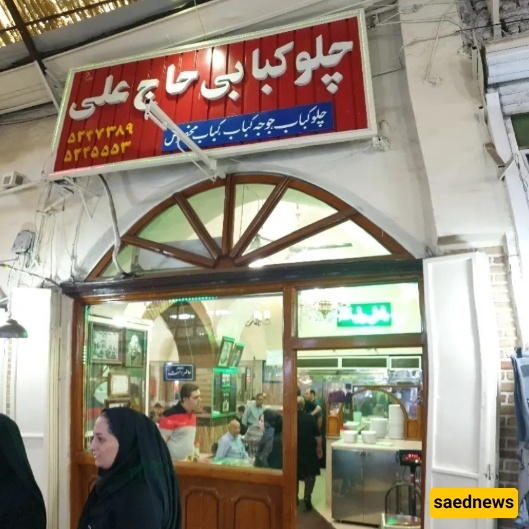
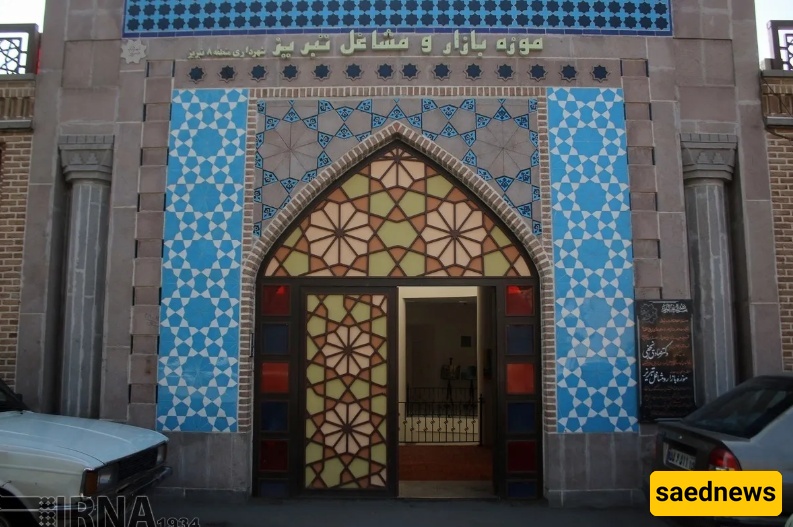

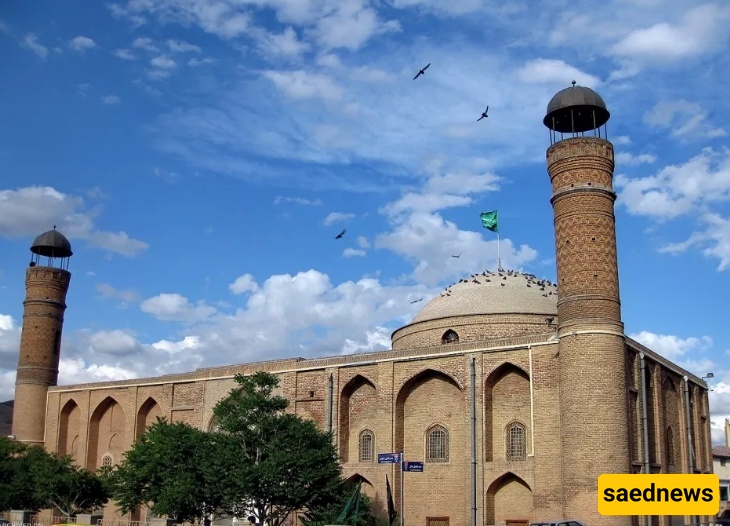
When researching Tabriz Bazaar, you will find in various sources and websites the claim that Tabriz Bazaar is the largest covered bazaar in the world—a distinguishing feature that attracts much attention. However, during our research, we also encountered information indicating that the Grand Bazaar in Istanbul is known in some sources as the oldest and largest covered bazaar worldwide. This prompted us to conduct a comprehensive study of the area of Tabriz Bazaar and the reality of whether it is truly the largest bazaar in the world.
Our first source was the UNESCO World Heritage website. In the documents related to the registration of Tabriz Bazaar on this site, the importance, age, and large size of the bazaar were emphasized, but it did not mention that it is the largest covered bazaar globally. Meanwhile, on the Iranian World Heritage Sites Management website, under the section about Tabriz Bazaar, it is stated that this beautiful historic structure is the largest registered heritage site in the country and the widest interconnected brick-covered complex in the world.
Additionally, a review of the English Wikipedia pages for both Istanbul’s Grand Bazaar and Tabriz Bazaar shows that Istanbul Grand Bazaar is known as one of the largest and oldest covered bazaars in the world, while Tabriz Bazaar is described as the largest covered bazaar. Similarly, in articles from the prestigious British newspaper The Guardian about the two bazaars, Tabriz Bazaar is referred to as the largest covered bazaar in the world, whereas Istanbul’s Grand Bazaar is considered one of the largest covered bazaars.
All these points, along with follow-ups conducted by the editorial team of Saed News in cooperation with the Cultural Heritage Organization of East Azerbaijan and other sources, have led us to conclude that Tabriz Bazaar is the largest and widest interconnected brick-covered complex in the world, and it is very likely also the largest covered bazaar worldwide.

